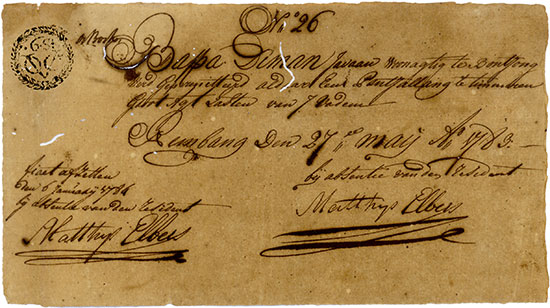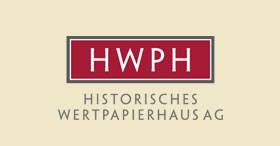Ingelsberg 17 b
D- 85604 Zorneding
Deutschland / Germany
Tel.: +49 (0)8106 - 2461-86
Fax: +49 (0)8106 - 2461-88
E-Mail: auktion@hwph.de
HWPH Historisches Wertpapierhaus AG –
Ваш специалист в области антикварных
ценных бумаг и истории финансов
|
||||
Лот |
1419 | |||
Наименование |
Oost-Indische Compagnie (V.O.C.) | |||
Место/-а выдачи |
Rembang | |||
Страна |
Indonesien, Niederlande | |||
Регион |
Asien | |||
Описание |
Rembang, 27.05.1789, Genehmigung für ein Poastboot (Schnellboot), #26, 11,5 x 20,7 cm, braun, handgeschrieben, Wurmlöcher, stark gebräunt, VOC-Stempel. | |||
Описание (Английский) |
Rembang, 27 May 1789, Approval for a Poastboot, #26, 11.5 x 20.7 cm, brown, handwritten, worm holes, tanned, VOC stamp. | |||
Сохранность |
F | |||
 |
||||
История (немецкий) |
Vasco da Gama erreichte am 20.05.1498 die Malabarküste. Als erster europäischer Seefahrer gelang er auf dem Seeweg um Afrika herum nach Indien. Diese Pionierleistung begründete die koloniale Vorherrschaft Portugals im Indischen Ozean. Gegen Ende des 16. Jahrhunderts entwickelte sich jedoch die niederländische Kartographie zur führenden in Europa. 1595 brach die erste niederländische Flotte unter Führung von Cornelis de Houtman nach Asien auf. Hierfür war die Compagnie van Verre gegründet worden. Die Expedition war wirtschaftlich sehr erfolgreich. Daher starteten 1598 fünf Expeditionen verschiedener Ostindischer Kompanien von unterschiedlichen niederländischen Hafenstädten. In den folgenden drei Jahren folgten neun weitere. Die Kompanien, die diese Expeditionen finanzierten, wurden nur für die Einzelreisen gegründet und nach Beendigung der Reise wurde der gesamte Gewinn realisiert. Eine Gründung von Handelsstationen oder ein kontinuierlicher Aufbau von Handelsbeziehungen fand durch diese Vorkompanien nicht statt. Bald kamen Forderungen nach einem Zusammenschluss der bisher konkurrierenden Gesellschaften auf. Vereinigungen einzelner Kompanien gab es bereits ab 1598 und bereits 1600 gründete man in Amsterdam die Eerste Vereinigde Compagnie op Oost-Indie, die bereits mit einem Handelsmonopol ausgestattet war, das sich aber noch auf städtischer Ebene bewegte. Dieses Monopol nahm die späteren V.O.C.-Privilegien weitgehend vorweg. Die Zeeländischen Compagnien schlossen sich diesem Unternehmen an, sodass am 20.03.1602 die föderal strukturierte Vereenigde Oostindische Compagnie (V.O.C.) begründet werden konnte. Die V.O.C. erhielt ein auf 21 Jahre befristetes Handelsmonopol für den Warenverkehr zwischen den Niederlanden und dem Gebiet östlich des Kaps der Guten Hoffnung und westlich der Magellan-Straße. Die V.O.C. besaß damit das Privileg als einzige Privat- oder Rechtsperson des Landes mit Ostindien Handel treiben zu dürfen. Für dieses Privileg zahlte die V.O.C. im Jahr 1602 nur 25.000 Gulden. Da die V.O.C. auch Souveränitätsrechte besaß, durfte sie Gouverneure ernennen sowie Armeen und Flotten aufstellen. In Asien konnte die V.O.C. daher wie ein souveräner Staat agieren. Jede der ursprünglichen sechs Kompanien, die in der V.O.C. zusammengeführt worden waren, erhielt eine regionale Verwaltung, die als Kammer bezeichnet wurde. Die Direktoren der in der V.O.C. zusammengeführten Gesellschaften wurden die Vorstände der V.O.C. Die Direktoren der V.O.C. beschlossen die historisch erstmalige Finanzierung der Gesellschaft durch die Ausgabe von Aktien. Die Aktionäre blieben zehn Jahre lang an ihre Aktien gebunden. Nachdem 1612 die Rückzahlung samt Zinsen erfolgte, konnten die Aktionäre für weitere zehn Jahre zeichnen. Zwar kamen fortan Dividendenzahlungen hinzu, allerdings hatten die Aktionäre noch keine Mitspracherechte. Im 17. Jahrhundert erlebte die V.O.C. einen beispiellosen Aufschwung. 1641 eroberte sie Malakka (heute Malaysia), das zuvor in portugiesischer Hand war. 1652 errichtete sie eine eigene Schiffstation am Kap der guten Hoffnung. 1659 wurde Palembang in Südsumatra erobert. 1667 wurde Makassar erobert. Damit fiel der letzte Hafen, von dem aus außerhalb der V.O.C. Handel aus Asien mit Europa geführt wurde. Als einzige Handelsgesellschaft erzielte die V.O.C. zwischen 1635 und 1690 mit dem Überseehandel Gewinne. Anschließend wurde der innerasiatische Handel zunehmend zur Einkommensquelle der Gesellschaft. Nachdem die Gesellschaft drei Englisch-Niederländische Kriege gut überstanden hatte, litt sie im vierten Krieg (1780-1784) deutlich. Die Rückkehrer aus Asien konnten die europäischen Heimathäfen nicht mehr anlaufen. Erlöse blieben aus. Hierdurch verlor die V.O.C. auch ihre Kreditwürdigkeit. Endgültig besiegelt wurde das Schicksal der V. O. C. mit dem Einmarsch der Franzosen in den Niederlanden. Vier Jahre vor ihrem 200jährigen Bestehen wurde die Gesellschaft am 17.03.1798 aufgelöst. | |||
История (английский) |
Vasco da Gama arrived at the Malabar Coast on 20 May 1498. He was commander of the first ships, which sailed around Africa directly from Europe to India. This achievement was the reason why Portugal was dominant in the Indian Ocean. The Dutch cartography developed to the leading in Europe at the end of the 16ht century. In 1595 the first Dutch fleet started to Asia. It was led by Cornelis de Houtman. For this reason the Compagnie van Verre was founded. The expedition was very successful. This was the reason, why five more expeditions – organized by other East-Indian-Compagnies – started from different Dutch cities in 1598. Nine more expeditions started in the following three years. At the time, it was customary for a company to be set up only for the duration of a single voyage, and to be liquidated on the return of the fleet. Because of this structure, no trade stations and no long-term trade relations were built. Shortly after the success of the first expeditions there was the idea of a merger of the competing companies. There were first joint-ventures already in 1598. In Amsterdam was the Eerste Vereinigde Compagnie op Oost-Indie founded in 1600. This company already got a monopoly for the trade with East-India, but the monopoly was only valid for the city of Amsterdam. The monopoly was similar to the monopoly which was later given to the V.O.C. Other companies joint the company, and the Vereenigde Oostindische Compagnie (V.O.C.) was founded on 20 March 1602. It got a trading monopoly which was valid for 21 years. The V.O.C. was the only person or company of the Netherlands who was allowed to trade with East India. The V.O.C. paid only 25,000 Gulden for this right in 1602. The V.O.C. also had sovereignty rights. The company was allowed to appoint Governors and to establish armies and fleets. The V.O.C. was able to act in Asia as a sovereign state. Each of the originally six companies, which merged in the V.O.C., got a regional office, which was called „Kammer”. The directors of the six companies built the executive committee of the V.O.C. For the first time in history the executive committee decided to finance the company by issuing shares. The shareholders were bound to their shares for ten years. In 1612 the invested money and interest was paid to the shareholders. It was possible to subscribe the shares for another ten years. In the following years the company paid also dividends. But the shareholders had nothing to say in the company. The V.O.C. saw a great boom during the 17th century. It conquered Malacca (today Malaysia) in 1641. This region was in Portuguese control before. The V.O.C. built an own trade station at the Cap of Good hope in 1652. Palembang in South Sumatra was conquered in 1659. Makassar was conquered in 1667. At this point the V.O.C. controlled all harbors in Asia. The V.O.C. was the only trading company which made profits during a period from 1635 to 1690. The company gained large parts of their profits with the Inner-Asian-Trade in the following years. The V.O.C. survived the first three wars between England and The Netherlands. The fourth war (1780-1784) caused problems. It was impossible for the returning ships to arrive at the European harbors of the V.O.C. The company lost money and their credibility. The final end of the V.O.C. was the invasion of the French in The Netherlands. The company was liquidated on 17 March 1798, four years before the Bi-Centennial anniversary. | |||
Обратите, пожалуйста, внимание на самые лучшие лоты нашего аукциона: |
||||













